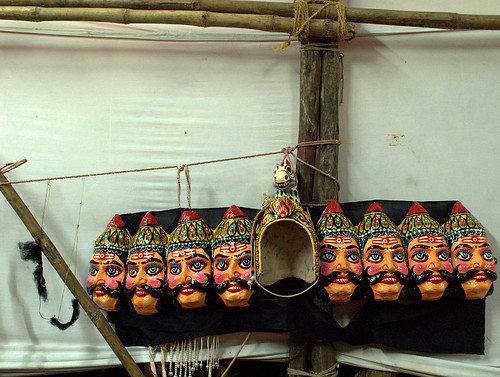
[Ravanna sans the most important face]
At every moment in our lives, perhaps, we are to some extent actors, or performers, as well as spectators. When performers and spectators "connect" it creates a very special quality of theater that both transports and transforms all those involved. In India we cherish this strong link between reality and fantasy first through theatre and now through film. All this age old mimicry of life somehow affects us and in return this mimicry is in itself a self-definition of the society we live in. This is the anthropology of theatre. I think Ram Lila or the enactment of Ramayana every Dassera stands as an example of this link between society and theatre. "Lila" or "Leela" roughly translated means "wonders by his grace" so RamLila should mean the creations/magic/wonders that Ram created with his abilities or the creative interpretation of the same by the actors of the Ram Lila itself. In other words the Ram Lila is a self-critique of Ram's life mirrored by the life of the actors that express it. The Ram Lila affects an entire population and has a dramatic and enduring effect on the lives of the poorest and the richest.
Since I was already fascinated by the socio-cultural importance of the tradition of Ram Lila I decided to visit Ram Lila Sabha at Cross Maidan. I spent the greater part of yesterday with the theatre artists of this Ramlila to get an idea of the training and production they go through, so that people like me outside theater come to a much deeper knowledge of the physical, emotional and intellectual demands made on such actors playing characters respected by the general public as gods no less.
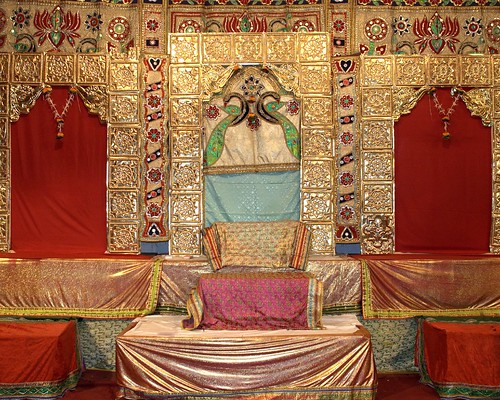
[The stage is yet to unfold]
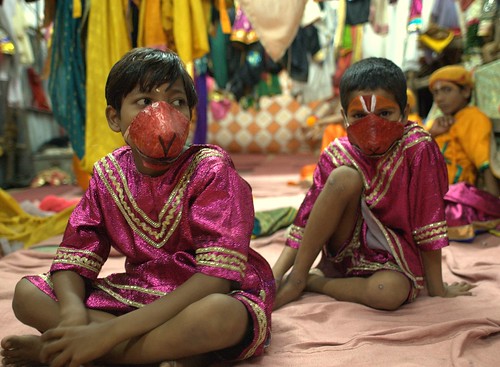
[Hanuman's many sidekicks]
There's music in every corner of the back tent in Cross Maidan. While a stray beat of the tabla distracts me, I can hear the collective sounds of "ghungroos" in the vicinity as the small group rehearses to the sounds of the Hanuman Chalisa. A group of men in their banyans sit cross legged in the foreground applying a rich array of face paints, while costumes, masks and a trunk full of props litter the tubelight lit hall of the tent. Now the soft murmurs of actors engaged in serious discussion can be heard. Sitting in the corner watching them prepare is in itself filled with degrees of drama. The picture of chaos is evident but then again it is a relaxed chaos slowly building up tempo to its crescendo when the curtains rise to hundred or so spectators to be dazzled by the story they know so well but still wish to see in technicolor reality for the umpteen time. Thirty minutes to "curtain rise" and Hanuman is still to attach his eyebrows and his tail has gone missing since the last performance; Ram can't find his right jhumka, Sita is straightening her [his actually as all Ramlila artists are men] blouse; Laxman is fiddling with Ram's bow and Ravana still not ready can be seen alternating between sips of a cup of chai and a beedi he borrowed from Sita. In other words it was all a messed up surreal dream exactly like the one I had about Jesus riding a Harley.
Many Stages of Hanuman
Stage 1
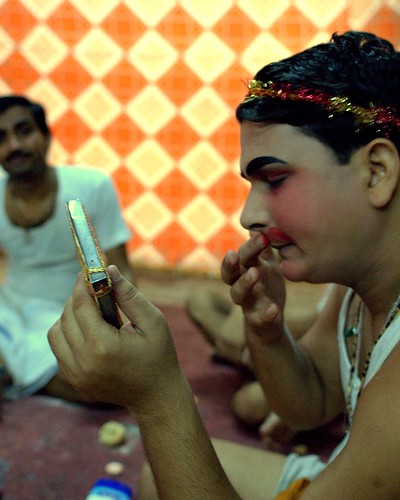
Stage 2
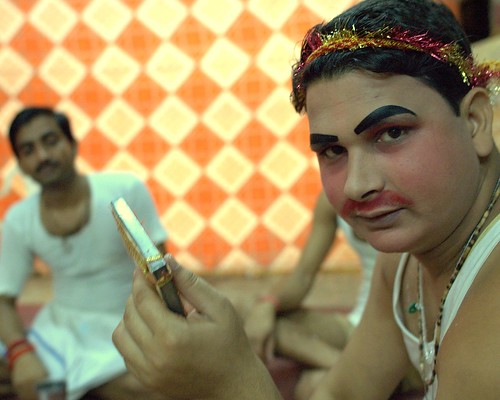
State 3
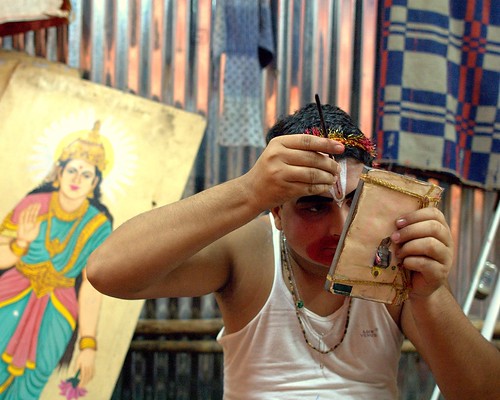
Stage 4
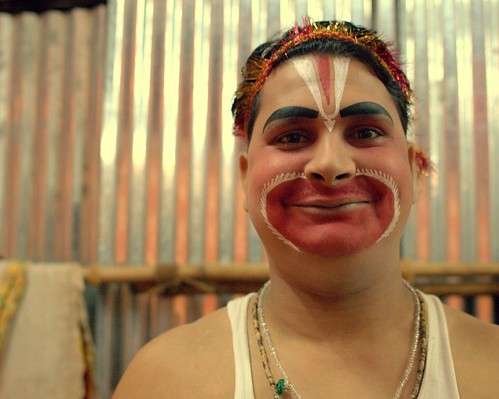
[& that is only the face]
While shooting Ram Lila artists I was faced with several dilemma or let me rephrase there were several Laxman rekhas I had to cross and be done with during the shoot besides the slowly deteriorating light in early evening. First, you can not shoot Ram or Laxman or Sita in the same frame as Ravana as its ungodly, second if Hanuman is be shot with Ram or Laxman he has be on his knees and the list goes on. What was more disappointing was the fact that they wouldn't let me a take a picture of myself in the Ravana mask. That would possibly have been the best ever blogger profile pic but alas it wasn't to be. It is all about getting into the character I guess.
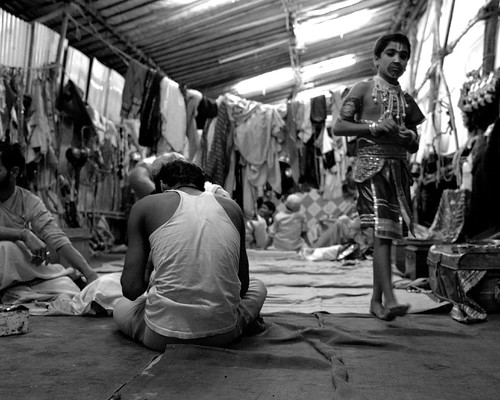
[20 minutes to curtain rise]
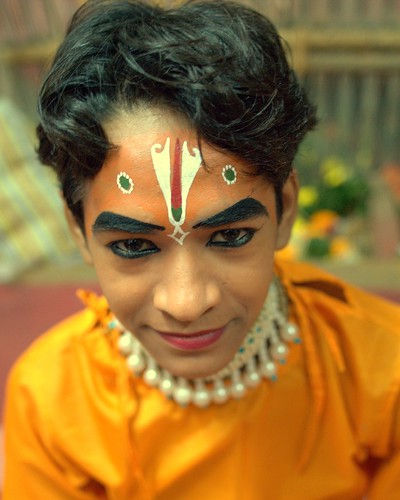
[Ram himself]
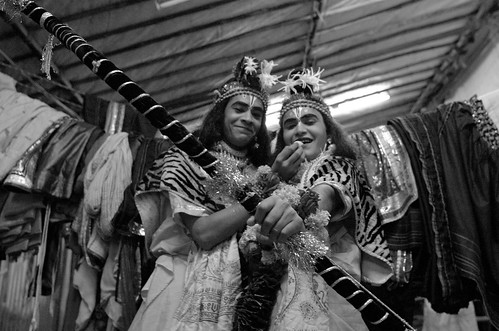
[Brother in Arms, Ram and Laxman are messing around with me]
All in all it was one of those rich Indian experiences that you only find by looking. It made me understand the essence of Ramleela and hence theatre and film. They implicitly ask us to re-evaluate our performances in our daily life, and discover for better or worse the social reality it reveals.
Youc can see rest of the photographs in series here - all images can be seen large clicking
[with inputs by Lavanya on flickr]
Unknown
Hi, We are templateify, we create best and free blogger templates for you all i hope you will like this blogify template we have put lot of effort on this template, Cheers, Follow us on: Facebook & Twitter